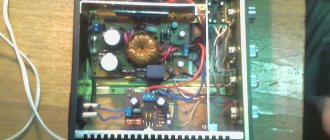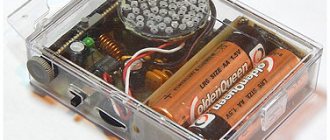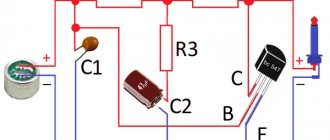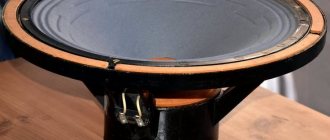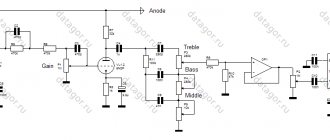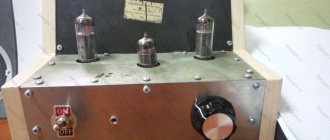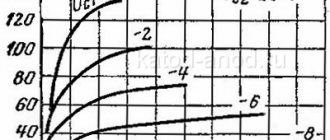Inexpensive speaker system with affordable speakers with a labyrinth, with good sound quality.
Article (1) was taken as a basis. Recommendations for manufacturing and calculation are described in detail in (2). See the list of references! For high-quality reproduction of low frequencies (bass), a low cutoff frequency, high output and no “booming” are required, i.e., a low quality factor of the main resonance. Practical implementation is shown in the figure.
The proposed acoustic system has good performance in its frequency range. It has a soft, comfortable and powerful sound, and most importantly it contains non-scarce and inexpensive dynamic heads: 6 GDV-4, 35GDN-4. This configuration has one drawback, a small dip in the midrange.
Characteristics:
Rated power 50 W Maximum power 100 W Frequency range 38 – 20,000 Hz Impedance 4 Ohm Sensitivity 89 dB Weight 19 kg
Simple loudspeaker with acoustic labyrinth
The variety of acoustic design options for loudspeakers allows you to realize the capabilities of the electrical path to varying degrees. The most common designs among radio amateurs are “closed box” and “bass reflex” - they are quite simple to manufacture. Somewhat less commonly used is acoustic design with passive radiators, acoustic resistance panels (ARPs), and very rarely - an acoustic labyrinth. This is where certain difficulties in its design come into play. This article offers a description of a loudspeaker with an acoustic labyrinth, which successfully combines ease of manufacture and, according to the author, good sound technical parameters.
The labyrinth is a series of internal partitions installed in the loudspeaker housing, forming zigzag channels through which sound vibrations from the rear side of the head diffuser pass to the outlet of the labyrinth.
If the length of this “passage” is close to λ/2 (where λ is the sound wavelength) at the lowest frequency (at 50 Hz λ/2 = 3.4 m), then the radiation from the exit hole of the labyrinth will be in phase with the radiation from front side of the diffuser.
In other words, the acoustic labyrinth makes it possible to improve the reproduction of the low-frequency portion of the sound range.
Another advantage of the labyrinth is that the back side of the diffuser emits sound vibrations almost into open space, which eliminates compression and the associated increase in the resonant frequency of the woofer head. The relatively short legs of the labyrinth (much less than λ) prevent the formation of standing waves, and covering them with sound-absorbing material acts like a PAS. The cross-sectional area of the labyrinth channel is usually made close to the diffuser area.
To expand the radiation pattern of loudspeakers in the region of higher sound frequencies, in the post-war years it was proposed to use scattering gratings and acoustic lenses. Despite the difficulties in manufacturing such devices, they are still used by some companies (for example, AIWA ). However, it was only recently possible to completely and simply solve the problem of obtaining a circular directivity characteristic of loudspeakers with the help of scattering cones installed opposite vertically located HF heads.
Circular directivity characteristics make it possible to obtain a uniform sound field in the horizontal plane throughout the entire frequency band. In such “spatial” sound, the stereo effect area is significantly expanded.
Taking into account the above, a loudspeaker with an acoustic labyrinth, accessible for self-production, was developed. Its body does not require thick plywood or chipboard, lined with scarce sound-absorbing materials on the inside. It is made in the form of a rigid vibration-resistant cylinder, eliminating any vibrations of its walls. A cross-section of a cylinder with heads installed in it is shown in Fig. 1.
Design of a simple acoustic system with an acoustic labyrinth
The loudspeaker uses LF head 16 - 35GDN-1-4, MF 8 - ZOGDS-117 (ZOGDS-1-8 is also possible), HF 3 - 6GDV-4-8. The cylinders of the midrange block 10 and the bass block 15 are glued together from wallpaper. The total thickness of their walls is 10 mm. The rigidity of the cylinders is increased by gluing plywood disks into the body, on which the bass and midrange heads are attached, and segments 17 (Fig. 2), rotated 180° relative to each other and forming an acoustic labyrinth.
For acoustic damping of the bass and midrange heads, soft felt 5-6 mm thick made of artificial wool is used. It is manufactured by the Scientific Research Institute of Nonwoven Materials (Serpukhov) under the name “needle-punched heat-noise-insulating fabric” and is sold in hardware stores. The use of this material makes it possible to significantly smooth out the frequency response of low-frequency and mid-frequency heads.
The internal disks of the speaker system are made of plywood (or chipboard) with a thickness of 16 mm (top panel 1 and bottom base 19 of the loudspeaker, disk 9 for attaching the midrange head 8 and the base of the midrange unit 10, disk 13 for attaching the woofer head 16) and 10 mm (segments 17 acoustic labyrinth). In the lower base 19 of the loudspeaker body (Fig. 3), 22 holes 20 with a diameter of 18 mm are drilled for the exit of sound vibrations, after which a stretched fabric is glued to it, performing the functions of a PAS.
Disks and segments are turned on a lathe or cut with a cutter. To mount the bass and midrange heads, holes are cut out in disks 9 and 13. Metal rectangles measuring 25x10x4 mm are attached to them from below using screws. In the center of these rectangles there are threaded holes into which stands 7 and 12 are screwed, securing the head to the disks through rubber gaskets.
Soul wide open
The easiest way to separate the front radiation of a speaker from the rear is to mount it on a shield as large as possible. From this simple idea, the first acoustic systems were born, which were a box with an open back wall, since for compactness the edges of the shield were simply taken and bent at a right angle. However, in terms of bass reproduction, the success of such designs was not very impressive. In addition to the imperfection of the body, the problem was also in the suspension travel of the diffusers, which was very small by modern standards. To somehow get out of the situation, speakers were used as large as possible, capable of developing acceptable sound pressure with a small vibration amplitude.
PureAudioProject Trio 15TB with 15" LF drivers on three-layer bamboo panels
Despite the seeming primitiveness of such designs, they also had some advantages, and they were so specific and interesting that adherents of open speakers have not died out to this day.
To begin with, the absence of any obstacles in the path of sound waves is the best way to increase sensitivity. This point is especially valuable for audiophile tube amplifiers, especially single-ended or feedbackless ones. Large-diameter paper diffusers, even at a power of about four to five watts, are capable of creating a rather impressive, and at the same time surprisingly open and free sound.
With a height of 1.2 m in the world of open acoustics, the Jamo R907 are considered almost compact
As for the rear radiation, in order not to introduce distortion into the direct sound, it must arrive to the listener with a noticeable delay (over 12-15 ms) - in this case, its influence is felt as a slight reverberation, only adding air to the sound and expanding the musical space . The subtlety is that to create this very “noticeable delay”, the speakers, of course, must be located at a fair distance from the walls. In addition, the large area of the front panel and the impressive size of the low-frequency drivers have a corresponding impact on the overall dimensions of the speakers. In a word, owners of small and even medium-sized living rooms, please do not worry.
By the way, a special case of open systems is acoustics built on electrostatic emitters. Only due to the almost weightless diaphragm of a large area, in addition to all the advantages described above, electrostats add the ability to delicately transmit even the sharpest dynamic contrasts, and due to the lack of signal separation in the midrange and treble zones, they also have enviable timbral accuracy.
Open design
Pros: High-end open-back speakers are a great way to get a real kick out of listening to purist tube single-ended speakers.
Cons: It’s better to forget about fat compression bass right away. The entire sound path must be subordinated to the idea of open acoustics, and the speakers themselves will have to be chosen from an extremely limited number of proposals.
YOUR OWN SOUND by Victor Razen or how to make an acoustic labyrinth
labyrinth rozhina acoustics ready
Hello to all lovers of good sound, in this article I would like to introduce you to Viktor Razen from Moscow, on my own behalf I would like to say that he is a good person, a real audiophile, he is not afraid of anything, he constantly experiments with sound.
— When did you first hear music?
The story about music has always made me admire the brainchild of Soviet sound engineers and sometimes fall back into childhood. I remember myself at the age of 3.5 years, when my father had a stand from Radiotekhnika, and those very red headphones in which he really liked to listen to music.
And these records, they fascinated me. And listening to them, I didn’t want to do anything and go to kindergarten. Yes, yes, you understood me correctly. I categorically refused to go there because my dad bought a new record with the fairy tale Robin Hood. My dad and I were often alone and listened to music together. It was loud and fun, and it was all from the past, the past 90s.
— Tell us about your proprietary system, how long it took you to assemble it, what it consists of. Acoustics amplifier, source?
Oh, this is a whole story consisting of multiple illusions. Perhaps, for this reason, it’s worth spending time and telling how it all happened and I’ll start in reverse order.
beginning of acoustics
Rozhin labyrinth - beginning 1
So, let's begin. Already as an adult, having three amazing sons, I very often heard them “fighting” over the phone and TV in order to listen to music and watch videos. Every night I heard music playing softly. At the same time, this made me angry and amused, because the boys are growing up and they need to start instilling a taste for the CORRECT MUSIC.
rozhina labyrinth - beginning
Turning to his work colleague, and knowing that he deals with guitars and does it very well. I asked him: “Alexey, what do you recommend?” Of course, Dear Readers, the reaction to my question was expressed by loud, friendly laughter, however, probably like yours now. After all, advising sound is like advising your best friend which wife to choose, and now you will understand why. I managed to purchase acoustics 35 AC 212.
These are the famous S-90 speakers in the USSR. I bought it, but they don't play. I can hear your kind laughter through your tears, asking me the question: where is the amplifier?
Radiotehnika-S-90
Of course, after a long time and rewinding the years, I remembered that same father’s “Radio Engineering” stand. I even managed to remember the name and brand of that wuxia. And, finally, I bought it, connected the wires and... voila, sound appeared.
labyrinth rozhina building
I'll tell you honestly, my ears became a bedding for bear paws, because with my ears it was - WOW. Now you understand why advising sound to people is like advising your best friend which wife to choose.
Let's do without a reel
Attempts to get rid of the genetic problems of the bass reflex, and at the same time save on the volume of the cabinet without compromising the depth of the bass, gave the developers the idea of replacing the hollow pipe with a membrane driven by vibrations of the same working volume of air. Simply put, another low-frequency driver was installed in a closed box, only without a magnet and voice coil.
A passive radiator can double the effective surface of the diffuser, or even triple it if they are installed in pairs in one column
The design was called “passive radiator”, which is often not very correctly translated from English as “passive radiator”. Unlike a subwoofer pipe, a passive diffuser takes up much less space in the case, is not so critical to the location, and besides, like the air inside a closed box, it dampens the leading driver, smoothing its frequency response.
Passive radiator subwoofer REL S/5. The main driver is directed to the floor
Another plus is that with an increase in the area of the radiating surface, to achieve the desired sound pressure, a smaller amplitude of vibrations is required, which means that the consequences of nonlinear operation of the suspension are reduced. Both diffusers oscillate in phase, and the resonant frequency of the free membrane is adjusted by precise adjustment of the mass - a weight is simply glued to it.
Passive radiator
Pros: Compact body with impressive bass depth. Lack of bass-reflex overtones.
Cons: An increase in the mass of the emitting elements leads to an increase in transient distortions and a slower impulse response.
Acoustics Labyrinth Rogozhin how to make an acoustics labyrinth
Acoustics labyrinth
rozhina labyrinth 3
rozhina labyrinth 2
Now I started having headaches. I told myself: you can’t make mistakes, repeated the proverb about measure seven times and cut once, and this went on for 2.5 months.
But the most difficult thing was the acoustic filters. Here I completed the entire training course in 10 days, learned everything I could.
decoration of the Rozhina labyrinth
The acoustic filter is based on the idea from acoustics 35 ac 212.
I didn't change the scheme. Only a serious upgrade : capacitors K73-16, K 74-4p and Mundorf, coil and jancer resistors. Body made of 16 mm plywood. Front 20 mm. Two middle Alphard ETP1300S2 and P.Audio PHT-407 HF driver with horn and speaker arrangement according to the D'Appolito system. Inside QED cable routing, to LF silver/copper
Rozhin's labyrinth inside
F.C. PC source, pсm 500 DAC, as well as a 30W/4Ohm hybrid amplifier, interconnect cable and RSA “Chernov” connectors
rozhina labyrinth - veneer
Appearance: veneer, two-component high-class varnish. Titanium alloy spikes on plates, quartz sand inside. Artificial stone stands are provided. The manufacturing of the housings took place on CNC machines and the speakers were assembled manually.
rozhina labyrinth dynamics fitting
That’s probably all that my system consists of, Dear Readers.
Most likely you will ask: what about the sound? You're right, the sound is the most interesting thing here. The stage is dynamic and spacious, the bass is clear and elastic, the two mids provide rich vocals, the highs convey purity so that when you close your eyes, you understand that a concert is playing next to you.
labyrinth rozhina dynamics
I've made a few videos, play it on your system and listen. I think and think you will appreciate this sound. Listening to the tracks was in high quality in flac format.
Rozhina labyrinth from the side
rozhina labyrinth design
Rozhina Dina's labyrinth
Currently, I am busy calculating the filter and in the near future you, dear readers, will be able to hear it and possibly see it live. This may upset many, however, it is possible to organize this for Moscow residents.
Rozhina labyrinth with filters Rozhina labyrinth side
rozhina labyrinth
I would like to express my deep gratitude to the people who helped me take my first steps into the World of sound, accompanying me in the right direction and instilling a love for sound:
You can always contact these people. They will always advise and help you.
— What would you like to wish to the readers of the Zvukomania website?
I’ll say one thing! - as many people, as many opinions, as many ears.
I can always share with you and give you advice.
labyrinth rozhina acoustics ready
Do you need a good phono preamplifier, a new tube amplifier or an excellent DAC, player, headphones, speakers or other audio equipment (amplifier, receiver, etc.) then write to VK, I will help you buy good audio equipment at a profitable price and with a guarantee...

